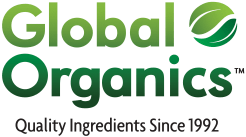Organic Ginger Juice - From Peru to You!
07.01.2019 | Author: Global Organics | Category: Fruit & Vegetable
Organic ginger juice has become a popular ingredient with craft beverage makers as it adds an intense spicy flavor profile to a variety of beverages. Of course, it also works well in sauces, soups, salad dressings and frozen entrees. Global Organics’ Director of Operations (Mark Novak) recently took a trip to Peru to visit our source for organic ginger juice. His goal was to see their farms and processing facility and to verify their organic status and quality and food safety protocols. Here’s a shortened version of Mark’s trip report and a good review of what happens in organic ginger juice’s journey from the farm to our warehouses.
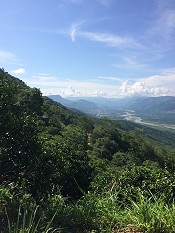
Trip Report: I flew into Lima, Peru and traveled 10 hours overnight across the Andes Mountains on winding, two-lane roads to Pinchanaki, the heart of Peru’s ginger production zone. The bus went from sea level to 4,818 meters (15,807 ft) through the famous Ticlio Pass and back down to 525 meters (1,722 ft) in the valley of the city. Pinchanaki lies in the foothills of the Andes Mountains as they descend into the Amazon basin. This tropical region is renowned for high quality and high flavor ginger. Organic production is fairly new in this area.
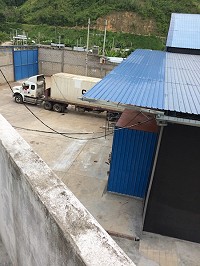
Getting off the bus at Pinchanaki, we drove for thirty minutes on rough paved roads to reach the entrance of Las Palmas, followed by another fifteen to twenty minutes on dirt roads before reaching the production compound. The processing facility is on a cleared section of land in the jungle next to a natural Amazon river tributary that flows from the Andes Mountains. The road is good enough for trucks pulling shipping containers to make it in and out. The processing facility is walled and fenced for security. The jungle is very close - in the evening, you could hear monkey calls. Since their location is remote, the facility is designed to be self-sufficient. They carefully maintain equipment, own back-up equipment, use solar panel lighting around the factory and walls at night, and train employees in back-up procedures.
Our supply partner grows their own ginger and buys a percentage from local farmers as well. Each lot of ginger has a number which can be traced back to the farm. When the processing facility was built the land was cleared in patterns that allow native animal species space and the ability to move freely. As opposed to most agriculture in the rainforest, organic ginger farming practices retain and reinvigorate soil fertility, instead of simply ‘mining’ the soil. Our supplier partner also uses cover crops to protect the soil. These environmental practices keep the land “nutrient rich” for growing future crops so no new land needs to be taken from the rainforest.
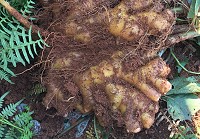 Ginger, commonly known as ginger root, is a rhizome that grows underground with floral aromatic leaves above ground. The Peru ginger season runs from July to the end of January. To harvest, workers use a heavy mattock (a cross between a hoe and a pickaxe) to dig away at the hillside soil, exposing the ginger root. The roots vary in size, with most the size of a large man’s hand.
Ginger, commonly known as ginger root, is a rhizome that grows underground with floral aromatic leaves above ground. The Peru ginger season runs from July to the end of January. To harvest, workers use a heavy mattock (a cross between a hoe and a pickaxe) to dig away at the hillside soil, exposing the ginger root. The roots vary in size, with most the size of a large man’s hand.
The day I visited, the harvesting area was roughly half a kilometer from and 200 meters below the collection shed. Harvested ginger is either bagged up or carried in crates by the farm workers for the uphill slog. [Good pictures of the harvest were lost due to my clumsiness; hiking down almost 400 meters of elevation, I did a face plant in the mud!]

Each day’s harvest is transported directly to the plant. The field harvested during my visit was about 20 kilometers from the processing facility. Lots of soil remains in the nooks and crannies of the ginger root (25% of the weight is soil). Roots are washed in a multistage process involving two 15-meter-long flumes of turbid fresh water, and a long hand cleaning line. Fans then blow cold air to dry the larger pieces of ginger before placing in retail packaging. The smaller pieces are reserved for juicing. The ginger goes from field to processing in less than 48 hours.
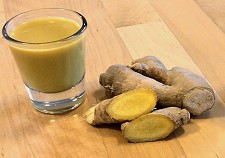 The ginger to be juiced is placed in 45 degrees F storage until it is needed. The juicing process involves milling and mechanically squeezed extraction under a controlled refrigerated temperature, essentially fresh cold pressing the juice. The juice obtained from this process is bright yellow and slightly cloudy due to some starchy plant material that is not strained out, as it adds pungency or spiciness to the juice. The juice is not pasteurized but immediately frozen to preserve a high standard of quality and color.
The ginger to be juiced is placed in 45 degrees F storage until it is needed. The juicing process involves milling and mechanically squeezed extraction under a controlled refrigerated temperature, essentially fresh cold pressing the juice. The juice obtained from this process is bright yellow and slightly cloudy due to some starchy plant material that is not strained out, as it adds pungency or spiciness to the juice. The juice is not pasteurized but immediately frozen to preserve a high standard of quality and color.
The frozen juice is then transported in freezer containers (with thermo-registers) by truck to the port of Callao for shipping. (Note: The juice must receive further processing to achieve the minimum 5-log reduction in pathogens as required by FDA.) Ginger juice made from ginger root at source (within a day or two of harvest) has a far fresher and more powerful ginger flavor than juice made from ginger root imported and processed in North America. Our sensory team did the taste test and agrees!
To learn more about organic ginger juice and obtain a sample, please contact your Global Organics Account Manager or email info@global-organics.com.
